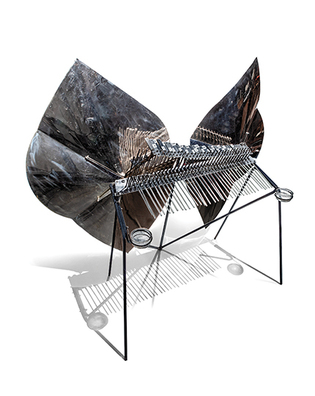 loading
loading
Arts & CultureFrom Baroque to moonscapeCristal Baschet is both a work of art and a musical instrument, and its timbres can oscillate from exquisite to otherworldly. Matthew Suttor is Professor in the Practice of Sound Design and director of the Beechman Center for Theatrical Sound and Music at Yale School of Drama.  Instrument collection, Beechman Center for Theatrical Sound and Music, Yale School of Drama. Photography by Bob Handelman.Cristal Baschet (facing page) is the most celebrated musical instrument produced by the Baschet brothers—an engineer and a sculptor who together created over 500 “sound sculptures.” View full imageA universe away from Benjamin Franklin’s genteel mechanical armonica, Cristal Baschet is a fantastical reimagining of a crystallophone—a musical instrument that produces sound from glass. The French brothers and artists Bernard and François Baschet—an engineer and a sculptor, respectively—began experimenting with glass rods on December 27, 1955; so wrote François in Les Structures Sonores, a candid 1999 history of their work and their encounters with the cultural elite in post-war Paris and New York. With their only scientific equipment a pair of flea-market stethoscopes, the Baschet brothers created over 500 sound sculptures (structures, as they called them), beginning in the early 1950s and remaining active well into their 90s. Some structures were playful riffs on standard instruments, like an inflatable guitar, and others were uncategorizable, like the Ticklephone. Their most celebrated musical instrument, Cristal Baschet, is not a single invention but a continuous conceptual reinvention. Attracting composers and musicians from Toru Takemitsu to Ravi Shankar to Radiohead, Cristal was featured in the score for Jean Cocteau’s 1960 film Le Testament d’Orphée, exhibited at MoMA in 1965, and recently sampled by the French electronica duo Daft Punk. Yale’s instrument, Two Sheet Metal Cristal, was made sometime between 1968–1972. Constructed from the iconic mid-twentieth-century art materials of aluminum, chrome, glass, and steel, Cristal seems more satellite than musical instrument. The two shield-like chrome resonators, or “flames,” stand 55 inches tall and together span six feet. There is no right or wrong way to play or even tune Cristal. The player’s fingers—using water as rosin, like a violinist’s bow—activate a manual of 36 nine-inch polished glass rods. The threaded metal tuning rods, to which the glass rods attach perpendicularly, make a strange echoing xylophone. The three-octave chromatic range, from G on the bottom of the bass clef to G on the top of the treble clef, is not unusually wide, but its flexible tuning system allows for musical temperaments extending from Baroque to moonscape. First-time listeners are shocked at the visceral impact of Cristal’s loud metallic trumpet—indelicately described by François Baschet as sounding like “an elephant in heat.” The dynamic range and timbral variation are vast. From a wisp of wind to a thunderous trombone-like crack, it is possible to play conventionally voiced tonal chords or strange, shifting atonal clusters. The timbres can effortlessly oscillate from exquisite to otherworldly.
In the cultural tumult following the Second World War, French composer Pierre Schaeffer began experimenting with the manipulation of recorded sound, which he dubbed musique concrète. The Baschet brothers too were drawn to creating electronic sounds, but through acoustic means: “We can make sound with these bars which ‘music concrète’ or electronic music can make only with enormous equipment. And moreover, synthetic music takes away the performer’s sensuous pleasure of becoming part of the instrument itself. One day musicians will need new equipment.” Paraphrasing Frank Lloyd Wright, François Baschet wrote in 1963 in the New Scientist “that music will not achieve its revolution until, like architecture, it renews its materials.” Cristal eventually became part of a “hands-on” collection at the Wadsworth Atheneum: an educational instrumentarium, as the Baschets thought of their collective instruments. There the sculptures were filmed, featured in bands, and played by countless children. But over time, they were left to neglect. In 2006, my colleague David Budries and I, together with a group of students from the School of Drama, rescued the instrumentarium from a welder’s garage near Glastonbury, Connecticut, and restored the instruments to playing condition. Cristal is a favorite with sound design students; it is possible you have heard its voice in the Yale Cabaret or in a Yale Rep production. We are happy to show Cristal by appointment, although—fair warning—the price of admission will be an impromptu performance.
The comment period has expired.
|
|